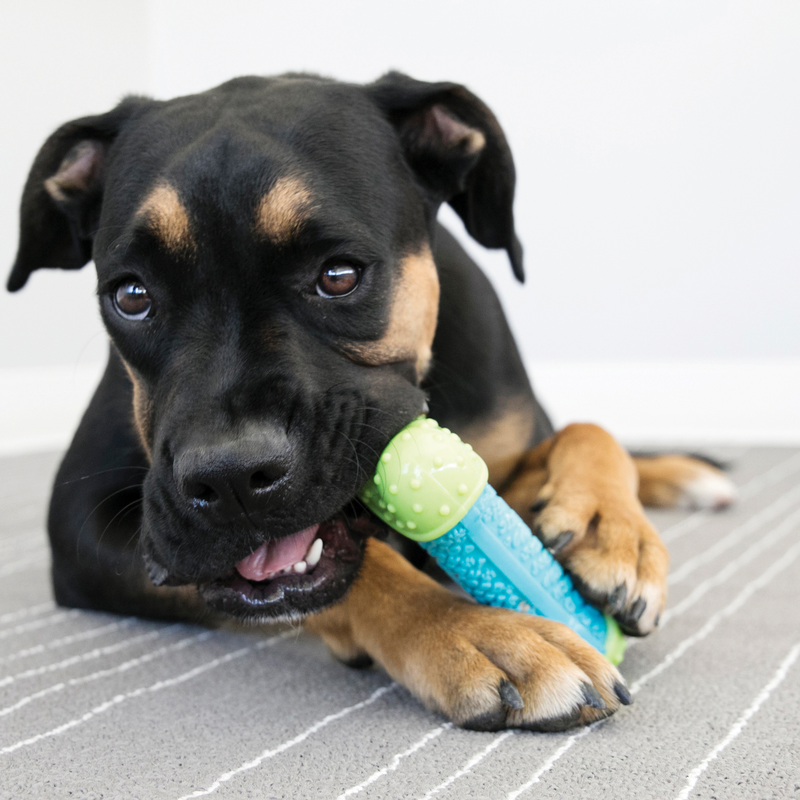How to Stop a Dog From Barking (2024 Pet Training Guide)
Is your pup’s incessant barking driving you and the neighbours crazy? We get it — a dog’s gotta do what a dog’s gotta do, but sometimes Fido takes it too far.
We’ve all been there, staring blankly at the ceiling while our furry friends make a racket downstairs. Don’t worry, you’re not alone. Many pet owners have struggled to curb excessive barking.
In the next few minutes, we’ll walk you through how to stop a dog from barking with some simple tricks. No more barking frenzy — just happy pets and happier owners.
Understanding Why Dogs Bark
Dogs bark for many reasons, and the first step to curbing excessive barking is figuring out why your dog is making so much noise.
Here are 4 common reasons dogs bark excessively:
- Boredom or loneliness
- Excitement or anxiety
- Need for attention
- Territorial behaviour
1. Boredom or Loneliness
If your dog exhibits excessive barking behaviour when you’re away from home, it may have separation anxiety or simply crave more of your attention. Make sure your dog has interactive toys, like a treat bone or jumbler ball, to keep it occupied, especially treat-dispensing toys that can keep it busy for hours. A tired dog is less likely to bark from boredom or loneliness. You should also spend quality time with your dog when you’re home to help alleviate its loneliness.
2. Excitement or Anxiety
Some dogs bark out of excitement, anxiety, or in reaction to outside noises. Engage your dog in exercise and playful activities to release pent-up energy and anxiety. If they’re barking in a dog park, they’re most likely dealing with anxiety. You can try giving them a safe space away from outside stimuli.
3. Need for Attention
If your dog stands or sits directly in front of you while barking, it’s likely doing so for attention. If your dog barks for attention or because it wants food, treats, or play, ignore the barking and reward it when it’s quiet. Don’t give in to their demands for attention when they’re noisy. Instead, redirect them to an appropriate behaviour like “sit” or “lie down” and reward that behaviour.
4. Territorial Behaviour
Dogs are naturally territorial and may bark excessively in response to people or other dogs in or near their yards. If you notice dog bark sessions due to territoriality, keep them occupied in the yard by providing them with interactive dog toys or consider securely confining them to an indoor area when there is a trigger around.

The key is determining why your dog is barking and taking appropriate steps to modify its behaviour humanely. Stopping a dog from compulsive barking requires some patience and perseverance. Read on to learn some effective training methods to prevent your canine friend from exhibiting this behaviour.
How to Stop Dog Barking in Seconds With Training
Dogs barking can be annoying, but with the right training, you can put an end to it.
Here is how to stop your dog from barking:
- Desensitise your dog to triggers.
- Teach them the “quiet” command.
- Use positive reinforcement.
- Address the underlying cause.
1. Desensitise your dog to triggers.
Your dog barks at things that startle or excite it, so desensitising it to these triggers can help. Repeatedly expose it to the trigger in a controlled setting while rewarding it for being quiet. Over time, it will learn that barking isn’t necessary.
For example, if it barks at noises outside, play recordings of those sounds while giving treats and praise for not barking. Gradually, it will get used to it.
2. Teach them the “quiet” command.
Teaching your dog the “quiet” command gives them an alternative behaviour to barking. When they start barking, say “quiet,” wait for them to stop barking, even if just for a second, then reward them. Practise this regularly, especially when the trigger that usually causes barking occurs. Over time, they’ll learn to stop barking when you say “quiet” in order to get a treat.
3. Use positive reinforcement.
Positive reinforcement, such as treats, play, and praise, is the most effective way to train your dog. Avoid scolding or punishing, which will likely just frighten or confuse them. Instead, reward them when they do something right, like stopping barking on command. Provide extra treats and play when they’re well-behaved to keep them motivated.
4. Address the underlying cause.
Sometimes, dogs bark due to anxiety, boredom or excess energy. Make sure your dog gets plenty of exercise, playtime, and affection so they can relax and de-stress. Puzzle toys or chew toys can keep them occupied when alone.
If they seem particularly anxious, talk to your vet or a certified professional dog trainer about anxiety medication or behavioural techniques to try. Addressing these underlying issues, along with training, is key to curing excessive barking for good.
With consistency and patience, these training techniques can help stop your dog’s barking fast and for the long term. Stick with them, and you’ll have a calmer, quieter companion by your side! In the next section, we explore some distraction methods to stop your dog from barking.
How to Stop Dog Barking Quickly With Distractions
In addition to stopping a dog’s barking through training, you can employ some distraction methods to quickly calm them on the spot.
Here are some effective tricks:
- Offer a treat.
- Grab a toy.
- Give them a puzzle.
- Take them outside.
1. Offer a treat.
When your dog starts barking, offer them a treat to redirect their attention. Hold the treat near their nose so they can smell it, and say “Quiet”. Once they stop barking, give them the treat and praise them. This helps teach them that being quiet is the behaviour that earns a reward.
2. Grab a toy.
Have some of your dog’s favourite toys on hand to distract them when barking. When they start making noise, squeak a toy or roll a ball to grab their attention. Play with them for a few minutes to keep them occupied. This redirection gives them an outlet for their energy and excitement.
3. Give them a puzzle.
Puzzles or interactive toys that dispense treats are great for keeping your dog occupied. Fill an interactive toy with some of their kibble or small treats and give it to them when they start barking. It will keep them busy trying to get the treats out, and the mental stimulation can help calm them. Look for toys that are challenging for your dog based on their size and intelligence.
3. Take them outside.
Sometimes, dogs bark out of excess energy or the desire to go outside. If your dog is barking by the door, take them out to the garden for a few minutes. Not only does it give them a chance to relieve themselves, but it also provides mental stimulation. Even just 10–15 minutes of outdoor time can help tire them out and satisfy their need to be outside.

The key to stopping nuisance barking quickly is to determine the underlying cause of your dog’s behaviour and provide an alternative that addresses that need. Whether your dog wants attention, food, play, or outdoor time, a quick distraction and redirection of their energy can help quiet them down fast. With consistency, these techniques will become second nature and help refine your dog’s ability to stop barking on command.
Lastly, there are some anti-barking devices that you can use to calm your dog when barking. Continue reading to learn more.
Using Anti-Barking Devices to Stop Your Dog From Barking
Some devices, such as ultrasonic devices and bark control systems, are specially made to help calm your dog down when barking. However, only explore these options as a last resort if everything else has failed. In as much as you want to control your pet’s annoying barking behaviour, you also want to prioritise their well-being at all times.
Ultrasonic Collars and Handheld Devices
Ultrasonic collars and handheld devices are two of the most common types of anti-barking devices. Ultrasonic collars are worn around your dog’s neck and activate automatically when they bark. Handheld devices are manually activated by you when your dog barks. Both options emit an unpleasant high-pitched sound to quiet your dog.
These devices are most effective for stubborn barkers or when you’re not home. They can effectively disrupt your dog’s barking patterns over time. However, for some dogs, the ultrasonic noise loses its effectiveness if used repeatedly. It’s best to use these gadgets intermittently, in combination with other anti-barking training and treats.
Bark Control Systems
Bark control systems offer an alternative to ultrasonic noise. These systems detect when your dog barks and then emit an audible warning noise, spray them with citronella spray, or give a small static shock. The goal is to deter excessive barking through an unpleasant consequence.
These types of systems may be more effective for some dogs, especially those not phased by ultrasonic sounds. However, punishment should only be deployed under guidance from a vet or professional dog trainer. Improper use of anti-barking devices when a dog is barking could lead to anxiety or aggression.

With time, patience, and consistency, using anti-barking devices responsibly in combination with training can help curb excessive barking and encourage better behaviour in your dog. But make sure to always put your dog’s well-being and happiness first. Excessive use of deterrents or punishment will likely backfire and damage your bond of trust.
For the best dog treats and toys, check out our online dog store.
Frequently Asked Questions
How Do You Stop Nuisance Barking?
Stopping nuisance barking involves understanding and addressing your dog’s needs. Create a comfortable living space to reduce stress-induced barking. Instead of scolding, redirect your dog’s attention and teach alternative dog communication behaviours.
Also, ensure they get enough exercise and stimulation. Be careful not to reinforce barking with attention or treats, as this can inadvertently encourage the behaviour.
How Do I Stop My Dog From Barking At Everything?
To stop your dog from barking at everything, start by optimising their living space for comfort and security. Distract and redirect their attention away from triggers.
Teach them quiet commands and reward calm behaviour. Ensure they get ample physical and mental exercise to burn off excess energy. Most importantly, avoid reinforcing the barking by giving in to their demands.
How Do You Discipline A Dog To Stop Barking?
To discipline a dog to stop barking, ignore the barking initially; it may persist, but with consistency, it’ll learn it gains no attention. If needed, use calm commands like “sit” or “lie down” to refocus its behaviour.
Always reward and interact with your dog when they’re calm to reinforce the quiet behaviour you want to see. Consistency is key here, so it may take some time to notice results.
What Is The Best Command To Stop A Dog From Barking?
The “quiet” command is highly effective for stopping a dog from barking. Teach it by speaking in a calm, firm tone. When your dog obeys and stops barking, immediately reward them with treats and affection to reinforce the behaviour. Consistent training with positive reinforcement will help your dog learn that silence is rewarded.
Conclusion
If you’re confused about how to stop a dog from barking, there are several strategies that you can explore, as outlined in this guide. Remember, don’t get angry or punish them. With a little patience and positive reinforcement, you can curb excessive barking gently and humanely.
Rather, pay attention to what’s triggering them and try addressing the root cause. And if all else fails, bring in the professionals to help.
But in most cases, a few tweaks to their routine and environment combined with some training should do the trick. With consistency and care, you’ll have a calmer, quieter companion in no time. For a variety of dog toys and treats that you can use to reinforce positive behaviour in your pet, check out our online dog store.





Leave a comment